Tula Technology Inc. and its sister company, Tula e Technology, are focused on developing technology to increase the efficiency of electric vehicles as a way to support the growth of vehicle electrification. The San Jose-based companies recently conducted media briefings in Novi, Michigan, which included test drives of electric vehicles equipped with Tula tech, such as a Chevrolet Bolt and a Tesla Model 3.
Tula has created Dynamic Motor Drive (DMD) software, designed to optimize efficiency while an electric vehicle is in operation. The company is collaborating with automakers and major suppliers to integrate this technology into electric vehicles. According to R. Scott Bailey, Tula CEO, the company is small, with around 50 employees, and is primarily focused on software development.
Initially founded in 2008, Tula initially worked on technology to deactivate cylinders in internal combustion engines based on operating conditions to reduce emissions. This led to a partnership with General Motors, with Tula technology being utilized in GM vehicles. However, by 2018, the company recognized the growing importance of electric propulsion and decided to shift its focus to the EV space.
The DMD software by Tula regulates torque and adjusts energy input to increase efficiency. When combined with externally excited synchronous motors (EESMs), Tula claims that energy consumption can be reduced by up to 3% over the course of a drive. Although this may seem like a small improvement, the company believes that multiple efficiency gains will be necessary to address various challenges in electric vehicle technology.
During the test drives, a dashboard display provided real-time updates on efficiency gains, allowing drivers to monitor changes in efficiency along different routes. Tula purchased the two EVs that were used in the test drives and installed its DMD software on them. The company believes that consistent improvements in efficiency can lead to benefits such as smaller batteries and reduced weight for electric vehicles.
As the electric vehicle industry continues to evolve, efforts are being made to reduce the cost gaps between electric vehicles and traditional internal combustion engine vehicles, as well as increase the travel ranges of EVs between charges. Despite recent reports of softened demand for EVs and production adjustments by companies like GM, there is still a strong focus on transitioning towards an all-electric future in the automotive industry.

